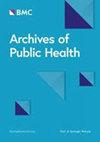艰难梭菌感染患者住院时间的影响因素分析:一项横断面研究
IF 3.2
3区 医学
Q2 PUBLIC, ENVIRONMENTAL & OCCUPATIONAL HEALTH
引用次数: 0
摘要
艰难梭菌感染(CDI)是由革兰氏阳性厌氧艰难梭菌引起的一种传染病。易感染 CDI 的人群包括老年人、免疫力低下者和住院病人,尤其是正在接受抗菌药物治疗的病人,这是导致这种感染的一个重要风险因素。由于其并发症和抗药性的增加,CDI 通常会导致住院时间延长。本研究旨在确定波兰 CDI 患者的平均住院时间(LOS),并找出影响感染患者住院时间的因素。研究分析了2016-2018年间在波兰最大的一家临床医院接受CDI治疗的成年患者的医疗记录。信息包括患者的年龄、部分实验室检查的LOS结果、使用抗生素的次数、基于营养风险筛查(NRS 2002)的营养状况、住院年份、入院时是否腹泻、全身感染、其他情况以及接受的治疗。系统收集这些变量为全面分析影响住院时间的因素奠定了基础。在研究期间,共有 319 名 CDI 患者住院,中位住院时间为 24 天(最小-最大 = 2-344 天)。2016年的平均住院时间为4.74天(中位数=28天),2017年为4.27天(中位数=24天),2018年为4.25天(中位数=23天)。两者呈弱负相关(Rho = -0.235,P 0.05)。然而,多变量回归模型解释了住院时间差异的很大一部分,R 方值为 0.844。CDI 患者的住院时间很长。住院时间长的患者白蛋白水平低,营养不良的风险增加。住院时间较长的患者患有肺炎、中风或手术,入院原因与 CDI 无关。本文章由计算机程序翻译,如有差异,请以英文原文为准。
Analysis of factors affecting the length of hospitalization of patients with Clostridioides difficile infection: a cross-sectional study
Clostridioides difficile infection (CDI) is an infectious disease caused by the gram-positive, anaerobic bacterium C. difficile. The vulnerable populations for CDI include the elderly, immunocompromised individuals, and hospitalized patients, especially those undergoing antimicrobial therapy, which is a significant risk factor for this infection. Due to its complications and increased resistance to treatment, CDI often leads to longer hospital stays. This study aimed to determine the average length of hospital stay (LOS) of Polish patients with CDI and to identify factors affecting the LOS of infected patients. The study analyzed medical records of adult patients treated with CDI in one of the biggest clinical hospitals in Poland between 2016–2018. Information encompassed the patient's age, LOS results of selected laboratory tests, number of antibiotics used, nutritional status based on Nutritional Risk Screening (NRS 2002), year of hospitalization, presence of diarrhea on admission, systemic infections, additional conditions, and undergone therapies. The systematic collection of these variables forms the foundation for a comprehensive analysis of factors influencing the length of stay. In the study period, 319 patients with CDI were hospitalized, with a median LOS of 24 days (min–max = 2–344 days). The average LOS was 4.74 days in 2016 (median = 28 days), 4.27 days in 2017 (median = 24 days), and 4.25 days in 2018 (median = 23 days). There was a weak negative correlation (Rho = -0.235, p < 0.001) between albumin level and LOS and a weak positive correlation between NRS and LOS (Rho = 0.219, p < 0.001). Patients admitted with diarrhea, a history of stroke or pneumonia, those taking certain antibiotics (penicillins, cephalosporins, carbapenems, fluoroquinolones, aminoglycosides, colistin), and those using proton pump inhibitors, exhibited longer hospitalizations (all p < 0.001) or unfortunately died (p = 0.008). None of the individual predictors such as albumin level, Nutritional Risk Screen, pneumonia, stroke, and age showed a statistically significant relationship with the LOS (p > 0.05). However, the multivariate regression model explained a substantial portion of the variance in hospitalization length, with an R-squared value of 0.844. Hospitalization of a patient with CDI is long. Low albumin levels and increased risk of malnutrition were observed in longer hospitalized patients. Longer hospitalized patients had pneumonia, stroke, or surgery, and were admitted for a reason other than CDI.
求助全文
通过发布文献求助,成功后即可免费获取论文全文。
去求助
来源期刊

Archives of Public Health
Medicine-Public Health, Environmental and Occupational Health
CiteScore
4.80
自引率
3.00%
发文量
244
审稿时长
16 weeks
期刊介绍:
rchives of Public Health is a broad scope public health journal, dedicated to publishing all sound science in the field of public health. The journal aims to better the understanding of the health of populations. The journal contributes to public health knowledge, enhances the interaction between research, policy and practice and stimulates public health monitoring and indicator development. The journal considers submissions on health outcomes and their determinants, with clear statements about the public health and policy implications. Archives of Public Health welcomes methodological papers (e.g., on study design and bias), papers on health services research, health economics, community interventions, and epidemiological studies dealing with international comparisons, the determinants of inequality in health, and the environmental, behavioural, social, demographic and occupational correlates of health and diseases.
 求助内容:
求助内容: 应助结果提醒方式:
应助结果提醒方式:


